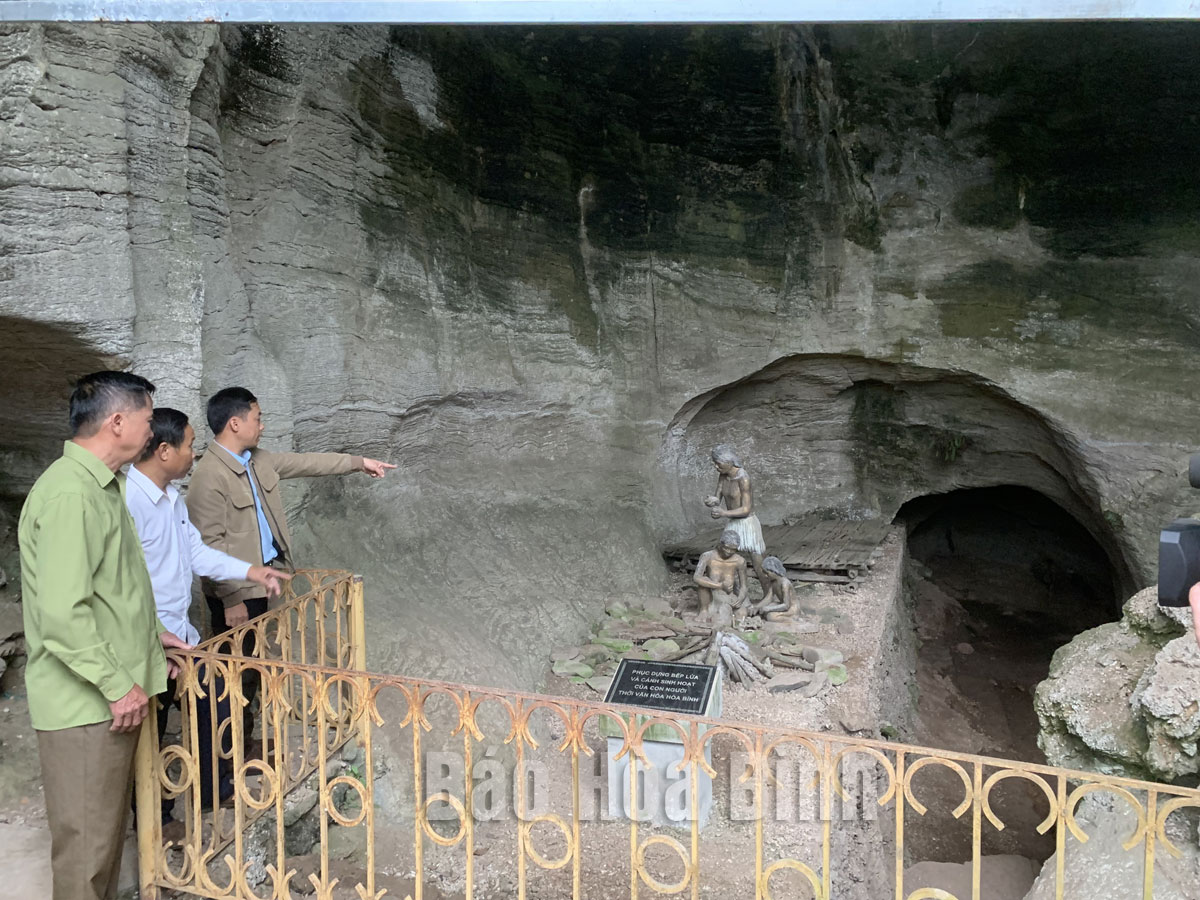
(HBO) – Hoa Binh province is home to the largest number of archaeological sites of the Hoa Binh Civilisation, which existed in not only Vietnam but also other countries in Southeast Asia about 30,000 - 4,000 years ago. Those sites spread in different densities almost across the province.
The Trai hamlet cave in Tan Lap commune (Lac Son district) is one of the outstanding archaeological sites dating back to the Hoa Binh Civilisation.
At least 72 sites dating back to the Hoa Binh Civilisation have been found in the province so far. They include the Vanh village stone shelter in Yen Phu commune and the Trai hamlet cave in Tan Lap commune of Lac Son district, which are two famous archaeological sites.
The Vanh village stone shelter, a typical archaeological site from the Hoa Binh Civilisation, was discovered and first excavated by French archaeologist M. Colani in 1929. Recognised as a national archaeological site in 2004, it contains stone tools, ceramic objects, and graves dating back 17,000 - 8,000 years.
Meanwhile, the Trai hamlet cave, also typical for the civilisation in Vietnam and Southeast Asia, was found in 1980 and first excavated by the Institute of Archaeology in 1981 and 1982. The 21,000-year-old cave served as a long-term place of residence as well as a tool making workshop and a burial site of people of the Hoa Binh Civilisation. It was listed as a national archaeological site in 2001.
Under the Ministry of Culture, Sports and Tourism’s Decision No. 1052/QĐ-BVHTTDL, dated May 6, 2022, on archaeological excavation, the provincial Department of Culture, Sports and Tourism and the Museum of Hoa Binh province coordinated with the Institute of Archaeology under the Vietnam Academy of Social Science and the Centre for Prehistoric Southeast Asian Studies to excavate the Vanh village stone shelter and the Trai hamlet cave. The excavation of the two national relic sites was completed, helping find new evidence of the civilisation, honour values of this cultural heritage, and express gratitude to archaeologist M. Colani and generations of domestic and foreign researchers and culture officials.
The Vanh village stone shelter and the Trai hamlet cave are typical representatives of the Hoa Binh Civilisation’s vestiges in Hoa Binh province and Vietnam at large. They also hold unique historical and cultural importance to become valuable tourism resources.
As directed by the provincial Party Committee’s standing members, the provincial People’s Committee issued a plan to build a scientific dossier seeking the recognition of the Vanh village stone shelter and the Trai hamlet cave in Lac Son district as special national relic sites.
The move is expected to affirm the importance of the two sites from the Hoa Binh Civilisation, which contain traces proving the presence of primitive humans in Vietnam and Southeast Asia, enrich historical and cultural tourism places in the province to help foster tourism development, and provide a legal basis for managing, protecting, restoring, and bringing into play the sites’ values./.
With an increasingly vibrant and widespread emulation movement aimed at building cultured residential areas and cultured families, Yen Thuy District has been making steady progress toward improving both the material and spiritual well-being of its people, while fostering a civilized, prosperous, beautiful, and progressive community.
Once lacking recreational spaces and community facilities, Residential Group 2 in Quynh Lam Ward (Hoa Binh City) has recently received attention for the construction of a new, spacious, and fully equipped cultural house. The project followed the model of state support combined with public contributions in both labor and funding.
The "All people unite to build cultural life" movement, which has been effectively integrated with Kim Boi district’s socio-economic development goals, is fostering a lively spirit of emulation across local residential areas, hamlets, villages, public agencies, and enterprises. In addition, through the initiative, traditional cultural values are being preserved and promoted, while community solidarity and mutual support in poverty reduction and economic development are being strengthened.
A working delegation of the Hoa Binh provincial People’s Committee led by its Permanent Vice Chairman Nguyen Van Toan on June 11 inspected the progress of a project to build the Mo Muong Cultural Heritage Conservation Space linked to tourism services in Hop Phong commune, Cao Phong district.
Born and growing in the heroic land of Muong Dong, Dinh Thi Kieu Dung, a resident in Bo town of Kim Boi district, in her childhood was nurtured by the sweet lullabies of her grandmother and mother. These melodies deeply imprinted on her soul, becoming an inseparable part of her love for her ethnic group's culture. For over 20 years, this love for her hometown has driven Dung to research, collect, and pass down the cultural values of the Muong people to future generations.
In the final days of May, the Ethnic Art Troupe of Hoa Binh Province organized performances to serve the people in remote, mountainous, and particularly disadvantaged areas within the province. These were not just ordinary artistic shows, but they were the meaningful journeys aimed at spreading cultural values, enhancing the spiritual life of the people and contributing to the preservation of ethnic minority cultural identities.



